|
Click pictures for a larger version.
UPDATE!

Kel-Tec KSG with Tan finish.








  

KSG holds 15 rounds of 12 gauge firepower.

Barrel on top above twin magazine tubes.

Slide (pump) release.


Crossbolt safety.

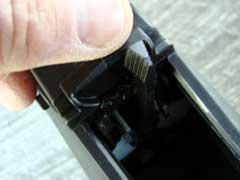

Magazine tube selector and cutoff.

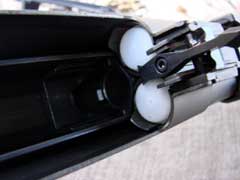



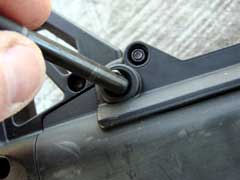



Disassembly requires no tools.

Hammer.


Bolt.


|
|
Kel-Tec CNC of Cocoa, Florida is well-known
for developing innovative weapons. Their 32
and 380 pocket pistols changed the
market for small pocket guns, effectively giving more power in a
smaller, lighter package for those who choose to carry a
concealed handgun. The more recent PMR-30
22 magnum pistol packs 31 rounds of firepower into a pistol
that weighs only nineteen ounces, fully loaded. The Kel-Tec
RFB bullpup rifle is innovative and practical, and is the
best bullpup semi-automatic 7.62mm rifle ever built. Kel-Tec’s
ability to constantly introduce unique weapons to the market is
sometimes frustrating to shooters who have trouble finding those
weapons in their local gun store, as the demand for Kel-Tec
firearms greatly exceeds the supply.
Kel-Tec introduced their revolutionary KSG
bullpup twin-magazine pump shotgun at the 2011
SHOT Show in Las Vegas. It has been a long wait, but
production KSG shotguns are now shipping from the factory. I
have had the opportunity to handle a couple of pre-production
units earlier, but now finally have had a production gun here
for a few days. From the introduction almost thirteen months
ago, I have been eager to get to run some ammo through a KSG,
and after spending a few days with the new shotgun, feeding it a
variety of ammo, taking it apart and studying the design, it has
exceeded my expectations.
I have seen a couple of other magazines “review”
the KSG months ago, but we like to wait for a production gun
which we can actually fire before doing a review, and as
expected, there have been a couple of improvements to the
original design. For one, the trigger now resets independently
of the slide working. The original design required that the
trigger be released before the slide was cycled. On the
production gun, that has been corrected, so that there is no
chance of pumping in another shell and finding that the weapon
is not ready to fire again. Another change is the design of the
slide lock (pump) switch: the new design is ambidextrous and
easily activated by the trigger finger with the hand still on
the pistol grip. Kel-Tec has also added small slots in the top
of each magazine tube to allow the operator to see if there are
shells in the tube. Nice touch.
Shotguns are very versatile firearms, and
have many sporting uses for target shooting and game hunting,
and are also very useful as fighting weapons. The KSG falls into
that later category. While the KSG could be used for clay target
shooting or for close-range small game and non-migratory bird
hunting, I doubt that many will be seen at the skeet range, nor
carried afield by a tweed-clad gent while following pointers in
pursuit of bobwhite quail. The KSG is purpose-built for a much
more serious role: that of decisively ending a serious social
conflict. Up close and personal, there is nothing quite like a
shotgun to quickly take the fight out of an assailant.
There are many good fighting shotguns on the
market, but none quite as short and handy, nor packing as much
firepower, as this Kel-Tec KSG. By using a bullpup design, the
Kel-Tec has an eighteen and one-half inch barrel to keep the
Feds happy, yet still has an overall length of only twenty-six
inches! That makes for a mighty handy-sized weapon to maneuver
in close quarters. The length-of-pull measures thirteen inches,
with a two and one-half inch trigger reach on the very
comfortable pistol grip. Four decades ago, the High Standard
Model 10 used a short bullpup design, but that weapon was
basically a modified sporting shotgun, the Flite King. It was
heavy and unreliable, but did prove the handiness of the bullpup
concept for a close-quarters fighting shotgun. It held between
five and seven rounds, depending upon the magazine used, but was
a semi-auto for right-handed shooters only. The twin magazine
tubes of the Kel-Tec KSG each carry seven twelve-gauge shells,
for a total loaded capacity of fifteen shots. The empty shotgun
shells eject out the bottom of the weapon, making this KSG
equally user-friendly for both right-handed and left-handed
operators. The manual safety pushes to the right side to fire,
using the thumb of a right-handed shooter, or the side of the
trigger finger for a left-hander.
The twin mag tubes offer a large loaded
capacity, but another advantage is that switching from one type
of ammunition to another is as quick and easy as flipping a
lever. In use, one tube could be loaded with buckshot for close
to moderate range work, with the other tube loaded with rifled
slugs for use at longer distances. Just pushing the lever to the
desired tube and pumping the slide instantly loads the preferred
type of ammunition. Within a dwelling, small birdshot is very
effective, yet not a lethal hazard to neighbors, losing
effectiveness rapidly after passing through a wall. One magazine
could be loaded with the birdshot, with the other tube stoked
with buckshot or slugs, in case the additional power is needed.
This unique ability of the KSG to carry various ammunition types
readily available for use is an advantage shared by no other
shotgun, with the exception of a double-barrel, which has very
limited capacity when compared to the KSG.
Besides the short overall length, the
straight-back design of the Kel-Tec makes it also well-suited
for fighting. Unlike most “tactical” shotguns on the market,
the KSG is not a modified sporting shotgun, shortened and
painted black for fighting purposes. While most of those adapted
shotgun designs also work well, the KSG handles better in close
quarters, and is also easy to fire using just one hand, if
needed.
The KSG has slightly over twelve inches of
Picatinny rail on top, and another six inches on the underside
of the forearm, to accommodate sights and accessories. There are
sling-mount points at the front and rear of the shotgun for
attachment of a carry sling, which is included with the KSG. The
KSG does not come equipped with sights, but plenty of good
mechanical and optical sights well-suited for a shotgun are
available. I chose to mount a Trijicon
Reflex dot sight atop the KSG. The Reflex is not some cheap
imported dot sight, but is built to be tough and durable, with a
heavy aluminum housing. The Reflex is always “on”, and never
needs batteries, with the dot illuminated by tritium and a
fiber-optic light-gathering unit atop the sight, to adjust
instantly to existing lighting conditions. In addition, I
mounted a Crimson Trace CMR-201
universal laser atop the rail, in front of the Reflex. The
laser is easily activated by the thumb of the support hand, and
makes hitting with the KSG easy from any position, even from
behind a barricade.
Hitting with a shotgun should be discussed a
bit, as many folks seem to be ignorant on this topic. A lot of
people who should know better often state something like, “Just
point the shotgun in the general direction, and you will hit
your target”. That is false. Across a typical room, the
shotgun, loaded with birdshot or buck, with make a fist-sized
hole in flesh, but will certainly not spread out and cover
everything in that entire compass direction. The shotgun still
must be aimed or pointed accurately, and having a proper sight,
whether mechanical or optical, makes hitting the target easier.
The KSG is very simple to disassemble for
basic cleaning and maintenance without the use of tools. Pushing
out two large pins allows the weapon to come apart enough to
keep it clean and running well. There are storage holes for the
two pins in the upper portion of the pistol grip, to keep them
secure while the weapon is disassembled. Loading the KSG is like
loading any tube-fed shotgun, with the exception of this one
having two tubes to load. The shells are pushed into one tube
until that tube is full, then the lever is switched to the other
tube for loading in the same manner. The KSG will fire either
two and three-quarter inch or three inch twelve gauge shotgun
shells. I have heard reports that it will also cycle the short
mini-shells on the market, but I cannot confirm that, as I have
not tried any and have no plans to do so.
The KSG is made primarily from reinforced
polymer and steel. The steel is finished in a matte black which
matches the polymer closely. The forearm and pistol grip have
Kel-Tec’s familiar waffle texture pattern. The KSG weighs in
at just a shade over seven pounds on my scale. The trigger
releases smoothly with four and one-half pounds of resistance.
The butt pad is a solid synthetic rubber. The slide works
smoothly. At the rear of the stroke, a cartridge is released
from the selected magazine tube upon the twin-armed lifter.
Moving the forearm forward, the lifter raises the shell into
position where it is carried forward by the bolt, which has a
lug that locks into the barrel extension. Upon pulling the
trigger, the hammer swings to strike the firing pin, and also
unlocks the slide to begin the cycle over again. When one
magazine runs empty, the operator switches the lever towards the
full magazine, and cycles the action to load from that tube.
I fired the KSG using a variety of twelve
gauge shotshells, from light target loads to three inch magnum
turkey loads. For defensive use inside a home, as mentioned
above, I like a good birdshot load using number 7 ½ or number 8
shot. These loads have light recoil, are devastating at short
range, and the pellets lose velocity quickly after penetrating a
wall. For offensive use or for use where over penetration is not
a concern, I like the 2 ¾ inch nine-pellet 00 buckshot loads,
or the Winchester PDX1 slug and buck load. If nine pellets are
not enough, the KSG can also fire the three inch fifteen-pellet
00 buck load. The versatile PDX1 shell carries a payload of a
one-ounce rifled slug and three 00 buck. At moderate range, it
patterns well, placing the slug in the center with the three
buckshot pellets surrounding that center hit. Where more
precision or greater distance is needed, either a 2 ¾ or 3 inch
rifled slug load packs a huge punch. As mentioned above, the
magazines can be loaded with different types of shells as
needed, offering instant selection of the preferred load for the
particular situation at hand.
The Kel-Tec KSG handled all
of these various loads reliably, with no failures to feed, fire,
nor eject, with one exception. After I had been putting a lot of
shells through the KSG, I started getting sticky extraction with
the Federal buckshot loads. A light coating of lubricant in the
back of the chamber corrected that problem, and the KSG again
functioned perfectly. The KSG is a shotgun like none other on
the market today, offering more firepower in a smaller package
than any other shotgun. Like any tube-fed shotgun, the tubes can
be loaded as needed without taking the weapon out of the fight.
For that reason, I prefer a tube-fed shotgun to a box magazine
shotgun for social work. The KSG is short, relatively
lightweight, and very handy to use. It is ambidextrous,
endearing the weapon to left-handed operators as well as
right-handed. The KSG balances well for one-handed use when
necessary, and has plenty of rail to accommodate mechanical or
optical sights, flashlights, and lasers. The KSG is another good
design from the fertile minds at Kel-Tec. The company has built
a reputation on designing some of the most innovative weapons on
the market, and the KSG follows in that tradition. After a long
wait, the Kel-Tec KSG is now shipping, so check it out online at
www.keltecweapons.com/.
Jeff Quinn
  
Got something to say about this article?
Want to agree (or disagree) with it? Click the following link to
go to the GUNBlast Feedback Page.
|
|
Click pictures for a larger version.
UPDATE!

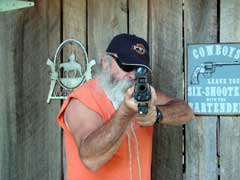


Crimson
Trace CMR-205 "Rail Master Pro" Red Laser / Tactical
Light unit.



XS Sight Systems
offset backup sights.

Leupold
DeltaPoint Reflex sight.
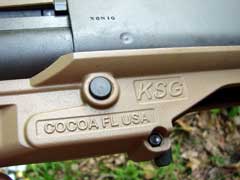
  

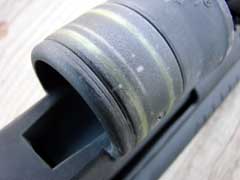
Trijicon Reflex sight is a perfect choice for the KSG.

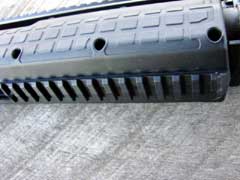
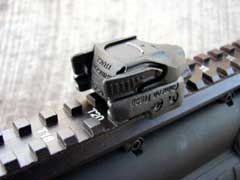



Crimson Trace CMR-201 universal laser.

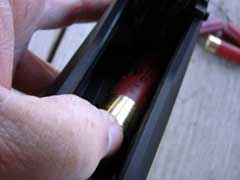
Magazine tubes load through ejection port.



Magazine tubes have windows to visually check loaded condition.





Sling attachment points.

Winchester PDX1 ammo.

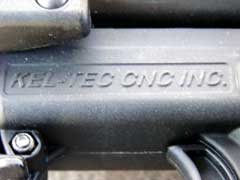
|
![]()